The Savory Ingredient That Takes Homemade Ranch Dressing To A New Level
Whether you're using ranch dressing as a dip for deep-fried pickles or smothering it atop a Southwest salad, the application opportunities are seemingly endless. One of the most enticing and yet underrated aspects of ranch is that it's highly customizable. Although you can make it basic, it's often fun to jazz things up a bit, so why not add miso paste to your next batch of homemade ranch dressing for a savory kick?
Miso paste is known for its rich, umami flavor, which brings a meaty, strapping edge to the tangy essence of classic ranch dressing. Salt, a key ingredient in miso paste, is a natural flavor enhancer that helps bolster some of the quintessential flavors of traditional ranch recipes such as dill, parsley, and chives. But it's not just the taste of your ranch that transforms under the influence of miso paste — the texture does, too. Miso paste is thick and dense, which gives ranch dressing an extra creamy consistency.
Although miso paste is a commonly used condiment in many Asian foods, it pairs quite well with a wide spectrum of cuisines. If you use your imagination, you might never run out of ways to use miso-kissed ranch dressing. Adding miso paste to your favorite ranch dressing recipe creates a fusion of flavors while simultaneously providing a nutritious twist.
What is miso paste?
Made from soybeans fermented with salt, grains, and a sweet-and-savory fungus called koji, miso paste has been a traditional Japanese condiment for over a thousand years. There are more than 1,000 varieties of miso paste, characterized by color, taste, and fermentation process. Generally speaking, however, miso paste can be categorized into two broad categories — red and white. The color and intensity of its umami profile are determined by how long the paste is fermented, and what it is fermented with. White miso paste typically is made with higher proportions of koji rice, fermented for shorter periods of time, and is sweeter and milder. Red miso paste is fermented for longer periods of time, made with higher proportions of soybeans, and offers a strong, savory essence.
White miso is an excellent option for a ranch dressing infusion, as it tends to have a more nuanced umami flavor. Red miso is usually stronger in flavor and is better suited for jazzing up animal proteins. Miso paste can easily be whisked into your homemade ranch dressing once you've emulsified all of the wet ingredients and herbs in your recipe.
Not only does this tasty ingredient pack a savory punch that livens up soups, stir-fries, and in this case, ranch dressing, but it also boasts a slew of nutritional benefits. Miso paste is low in calories, high in many essential vitamins and micronutrients, and contains probiotics that may improve digestion.
Ways to enjoy miso ranch
Now that you're eager to add miso paste to your next batch of homemade ranch dressing, you might need some ideas for putting it to use. If you don't know where to start, the good news is you can use it in any dish that you typically enjoy with ranch, or get creative and try something unique — the choice is yours.
Miso ranch is great for drizzling over grilled meats as it strengthens the natural umami kick of animal proteins without coming off too strong, and if you want to maximize the flavor blast, consider using the condiment as a marinade. Don't worry vegetarians, you can do the same thing with your favorite grilled or raw vegetable medley. Miso ranch is also a great addition to Buddha bowls and burgers or as a side for some spicy wings.
Don't be afraid to mix a little miso paste into your store-bought or restaurant ranch dressing, either. Chances are, if you enjoy a meal with ranch, you'll enjoy it even more with miso ranch.


